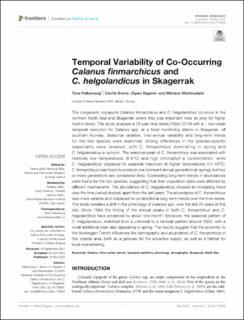| dc.contributor.author | Falkenhaug, Tone | |
| dc.contributor.author | Broms, Cecilie | |
| dc.contributor.author | Bagøien, Espen | |
| dc.contributor.author | Nikolioudakis, Nikolaos | |
| dc.date.accessioned | 2022-09-21T11:56:44Z | |
| dc.date.available | 2022-09-21T11:56:44Z | |
| dc.date.created | 2022-09-13T14:23:34Z | |
| dc.date.issued | 2022 | |
| dc.identifier.citation | Frontiers in Marine Science. 2022, 9 . | en_US |
| dc.identifier.issn | 2296-7745 | |
| dc.identifier.uri | https://hdl.handle.net/11250/3020208 | |
| dc.description.abstract | The congeneric copepods Calanus finmarchicus and C. helgolandicus co-occur in the northern North Sea and Skagerrak where they play important roles as prey for higher trophic levels. This study analyses a 26-year time series (1994-2019) with a ~ two-week temporal resolution for Calanus spp. at a fixed monitoring station in Skagerrak, off southern Norway. Seasonal variation, inter-annual variability and long-term trends for the two species were examined. Strong differences in the species-specific seasonality were revealed, with C. finmarchicus dominating in spring and C. helgolandicus in autumn. The seasonal peak of C. finmarchicus was associated with relatively low temperatures (6-8°C) and high chlorophyll a concentration, while C. helgolandicus displayed its seasonal maximum at higher temperatures (11-16°C). C. finmarchicus was found to produce one dominant annual generation (in spring), but two or more generations are considered likely. Contrasting long-term trends in abundances were found for the two species, suggesting that their population sizes were affected by different mechanisms. The abundance of C. helgolandicus showed an increasing trend over the time period studied, apart from the last years. The abundance of C. finmarchicus was more variable and displayed no unidirectional long-term trends over the time series. The study revealed a shift in the phenology of Calanus spp. over the last 25 years at this site. Since 1994 the timing of the annual peaks in both C. finmarchicus and C. helgolandicus have advanced by about one month. Moreover, the seasonal pattern of C. helgolandicus, switched from a unimodal to a bimodal pattern around 2002, with a small additional peak also appearing in spring. The results suggest that the proximity to the Norwegian Trench influences the demography and abundance of C. finmarchicus in this coastal area, both as a gateway for the advective supply, as well as a habitat for local overwintering. | en_US |
| dc.language.iso | eng | en_US |
| dc.title | Temporal Variability of Co-Occurring Calanus finmarchicus and C. helgolandicus in Skagerrak | en_US |
| dc.title.alternative | Temporal Variability of Co-Occurring Calanus finmarchicus and C. helgolandicus in Skagerrak | en_US |
| dc.type | Peer reviewed | en_US |
| dc.type | Journal article | en_US |
| dc.description.version | publishedVersion | en_US |
| dc.source.pagenumber | 17 | en_US |
| dc.source.volume | 9 | en_US |
| dc.source.journal | Frontiers in Marine Science | en_US |
| dc.identifier.doi | 10.3389/fmars.2022.779335 | |
| dc.identifier.cristin | 2051251 | |
| dc.relation.project | Norges forskningsråd: 299554 | en_US |
| dc.relation.project | Norges forskningsråd: 178679 | en_US |
| dc.relation.project | Norges forskningsråd: 200508 | en_US |
| cristin.ispublished | true | |
| cristin.fulltext | original | |
| cristin.qualitycode | 1 | |
